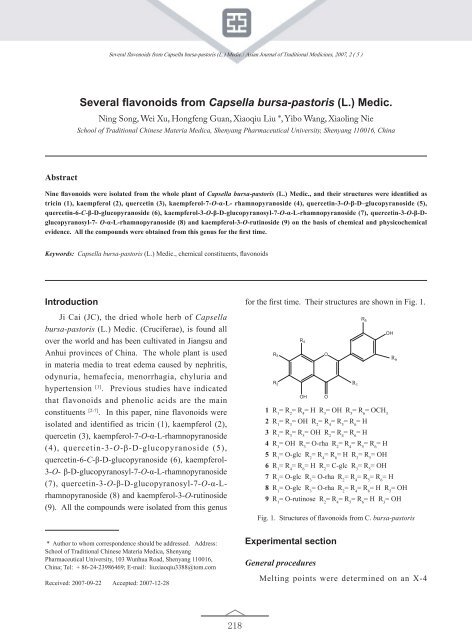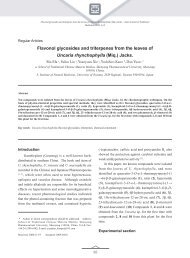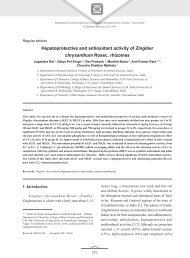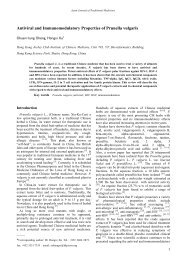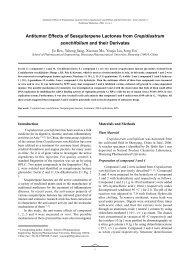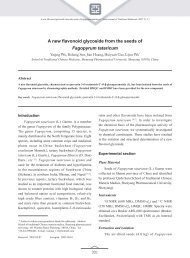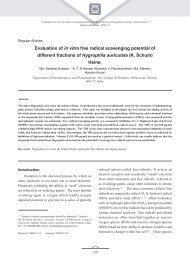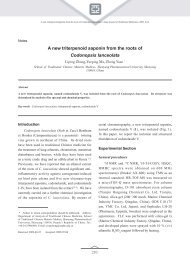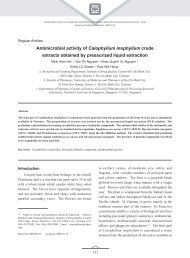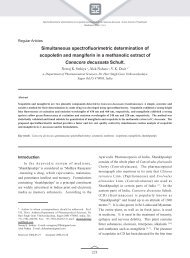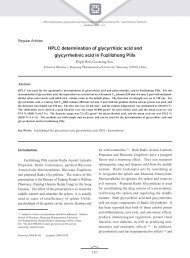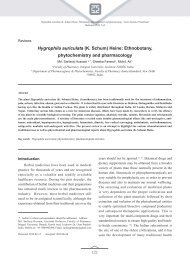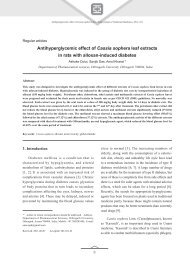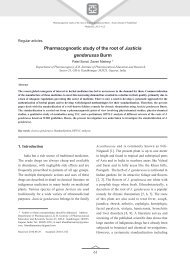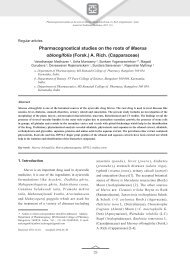Several flavonoids from Capsella bursa-pastoris (L.) Medic.
Several flavonoids from Capsella bursa-pastoris (L.) Medic.
Several flavonoids from Capsella bursa-pastoris (L.) Medic.
You also want an ePaper? Increase the reach of your titles
YUMPU automatically turns print PDFs into web optimized ePapers that Google loves.
<strong>Several</strong> <strong>flavonoids</strong> <strong>from</strong> <strong>Capsella</strong> <strong>bursa</strong>-<strong>pastoris</strong> (L.) <strong>Medic</strong>./ Asian Journal of Traditional <strong>Medic</strong>ines, 2007, 2 ( 5 )3.35~3.63 (m), 1.12 (3H, d, J = 6.2 Hz, H-6″ ). Alldata were identical with that of kaempferol-7-O-α-Lrhamnopyranoside[11] .-Compound 5Yellow amorphous powder, mp 231-232 ºC. 1 HNMR δ (300 MHz, DMSO-d 6) 12.64 (1H, s, 5-OH),7.59 (1H, d, J = 2.5 Hz, H-2′), 7.57 (1H, dd, J = 8.5,2.5 Hz, H-6′), 6.84 (1H, d, J = 8.7 Hz, H-5′), 6.40 (1H,d, J = 2.5 Hz, H-8), 6.20 (1H, d, J = 2.5 Hz, H-6), 5.47(1H, d, J = 6.9 Hz, H-1″), 5.4~3.0 (10H, m, glc). Alldata were identical with that of quercetin-3-O-β-Dglucopyranoside[12] .-Compound 6Yellow amorphous powder, mp 242-244 ºC, HCl-Mg reaction: positive, Molish reaction: positive. UVλ(max) nm: 255, 270, 348 (MeOH). 1 H NMR δ (300MHz, DMSO-d 6) 13.56 (1H, s, 5-OH), 7.42 (1H, d,J = 2.5 Hz, H-2′), 7.39 (1H, dd, J = 8.5, 2.5 Hz, H-6′), 6.86 (1H, d, J = 8.1 Hz, H-5′), 6.65 (1H, br.s, H-3),6.48 (1H, br.s, H-8), 4.59 (1H, d, J = 9.7 Hz, H-1″), 4.1~3.0 (10H, m, glc). 13 C NMR δ (75 MHz,DMSO-d 6) 163.4 (C-2), 102.8 (C-3), 181.9 (C-4),156.2 (C-5), 108.9 (C-6), 163.7 (C-7), 93.6 (C-8),160.7 (C-9), 103.4 (C-10), 118.9 (C-1′), 113.3 (C-2′), 145.8 (C-3′), 149.8 (C-4′), 116.1 (C-5′), 121.4 (C-6′), 73.1 (C-1″), 70.7 (C-2″), 78.9 (C-3″), 70.3 (C-4″),81.6 (C-5″), 61.5 (C-6″). All data were identical withthat of quercetin-6-C-β-D- glucopyranoside [13] .-Compound 7Yellow amorphous powder, HCl-Mg reaction:positive, Molish reaction: positive. 1 H NMR δ (300MHz, DMSO-d 6) 8.08 (2H, d, J = 8.8 Hz , H-2′, 6′), 6.90 (2H, d, J = 8.8 Hz , H-3′, 5′), 6.83 (H-8), 6.44(H-6), 5.55 (1H, br.s, H-1″′), 5.47 (1H, d, J = 7.2 Hz,H-1″), 1.10 (3H, d, J = 6.4 Hz, -CH3). 13 C NMR δ(75 MHz, DMSO-d 6) 177.8 (C-4), 161.6 (C-7), 160.9(C-5), 156.8 (C-2), 156.0 (C-9), 133.5 (C-3), 131.1(C-2′, C-6′), 120.8 (C-1′), 115.3 (C-3′, C-5′), 160.3(C-4′), 105.7 (C-10), 98.5 (C-6), 94.5 (C-8), 100.8(C-1″), 77.7 (C -5″), 76.5 (C-3″), 74.3 (C-2″), 70.2(C-4″), 60.9 (C-6″), 99.5 (C-1″′), 71.7 (C-4″′), 70.1(C-3″′), 70.0 (C-2″′), 69.7 (C-5″′), 18.0 (C-6″′). Alldata were identical with that of kaempferol-3-O-β-Dglucopyranosyl-7-O-α-L-rhamnopyranoside[14] .-Compound 8Yellow amorphous powder, HCl-Mg reaction:positive, Molish reaction: positive. 1 H NMR δ (300MHz, DMSO-d 6) 12.64 (1H, s, 5-OH), 7.62 (1H, d,J = 2.5 Hz, H-2′), 7.60 (1H, dd, J = 8.5, 2.5 Hz, H-6′), 6.85 (1H, d, J = 8.5 Hz, H-5′), 6.80 (1H, d, J = 2.5Hz, H-8), 6.43 (1H, d, J = 2.5 Hz, H-6), 5.49 (1H, d,J = 6.9 Hz, H-1″), 5.55 (1H, s, H-1″′), 5.4~3.0 (17H,m, glc and rha), 1.12 (3H, d, J = 6.0 Hz, -CH3). 13 CNMR δ (75 MHz, DMSO-d 6) δ156.8 (C-2), 133.7(C-3), 177.7 (C-4), 160.9 (C-5), 99.5 (C-6), 161.7(C-7), 94.4 (C-8), 156.8 (C-9), 105.7 (C-10), 121.8(C-1′), 115.3 (C-2′), 145.0 (C-3′), 148.9 (C-4′), 116.4(C-5′), 121.1 (C-6′), 100.8 (C-1″), 74.2 (C-2″), 76.6(C-3″), 70.3 (C-4″), 77.8 (C-5″), 61.1 (C-6″), 99.5(C-1″′), 70.0 (C-2″′), 70.2 (C-3″′), 71.7 (C-4″′), 69.9(C-5″′), 18.0 (C-6″′). All data were identical withthat of quercetin-3-O-β-D-glucopyra- nosyl-7-O-α-Lrhamnopyranoside[15] .-Compound 9Yellow amorphous powder, HCl-Mg reaction:positive, Molish reaction: positive. UV λ(max)nm: 225, 270, 350 (MeOH). 1 H NMR δ (300 MHz,DMSO-d 6,) 7.98 (2H, d, J = 8.7 Hz, H-2′, 6′), 6.88(2H, d, J = 8.7 Hz, H-3′, 5′), 6.40 (1H, br.s, H-8), 6.20(1H, br.s, H-6), 5.30 (1H, d, J = 6.9 Hz, H-1″), 4.39(1H, br.s, H-1″′), 3.0~4.0 (16H, rut), 1.10 (3H, d, J= 6.4 Hz, -CH3). 13 C NMR δ (75 MHz, DMSO-d 6)156.4 (C-2), 133.1 (C-3), 177.2 (C-4), 161.1 (C-5),98.7 (C-6), 164.0 (C-7), 93.7 (C-8), 156.7 (C-9), 103.7(C-10), 120.7 (C-1′), 130.7 (C-2′, C-6′), 115.0 (C-3′, C-5′), 159.8 (C-4′) , 101.3 (C-1″), 74.1 (C-2″), 76.3(C-3″), 69.8 (C-4″), 75.6 (C-5″), 66.8 (C-6″), 100.7(C-1″′), 70.2 (C-2″′), 70.5 (C-3″′), 71.7 (C-4″′), 68.1(C-5″′), 17.6 (C-6″′). All data were identical with that220
<strong>Several</strong> <strong>flavonoids</strong> <strong>from</strong> <strong>Capsella</strong> <strong>bursa</strong>-<strong>pastoris</strong> (L.) <strong>Medic</strong>./ Asian Journal of Traditional <strong>Medic</strong>ines, 2007, 2 ( 5 )of kaempferol-3-O-rutinoside [16] .Results and discussionNine <strong>flavonoids</strong> were isolated and identified bydetermining their physicochemical properties andspectral analysis. All the compounds were obtained<strong>from</strong> this genus for the first time.Compound 6 was isolated as a yellow, amorphouspowder <strong>from</strong> methanol. Three proton signals δ6.89(1H, d, J = 8.1 Hz), δ 7.39 (1H, dd, J = 8.1, 2.5 Hz)and δ 7.42 (1H, d, J = 2.5 Hz) indicated the presenceof an ABX coupling system. This showed that 3′, 4′ or 4′, 5′ were disubstituted on the B-ring. The 13 CNMR data showed that there were 21 carbon signals,15 of which were typical for a flavone skeleton, andthe others were assigned to a glycoside. There wereno anomeric carbon signals for sugar observed near100, which indicated that it was not an O-glycoside,but maybe a C-glyciside. Moreover, 1 H and 13 CNMR data were consistent with quercetin-6-C-β-D-glucopyranoside. Therefore, it was identified asquercetin-6-C-β-D-gluco- pyranoside.Compound 8 was isolated as a yellow, amorphouspowder <strong>from</strong> methanol. Three proton signals δ 6.85(1H, d, J = 8.5 Hz), δ 7.60 (1H, dd, J = 8.5, 2.5 Hz)and δ 7.62 (1H, d, J = 2.5 Hz) showed the presenceof an ABX coupling system. It was also found that3′, 4′ or 4′, 5′ were disubstituted on the B-ring. The13C NMR data indicated that there were 27 carbons inthis structure, 15 of which were typical for a flavoneskeleton, and the others were assigned to glycosides.Compound 8 was identified as quercetin-3-O-β-Dglucopyranosyl-7-O-α-L–rhamno-pyranoside bycomparing 1 H and 13 C NMR data with the literature.Compounds 7 and 9 were isolated as yellow,amorphous powders <strong>from</strong> methanol. Two sets ofsymmetric proton signals δ 8.08 (2H, d, J = 8.8 Hz),δ 6.90 (2H, d, J = 8.8 Hz) for compound 7 and δ7.98 (2H, d, J = 8.7 Hz), δ 6.88 (2H, d, J = 8.7 Hz)for compound 9 showed the presence of an AA′BB′ coupling system, which indicated that 4′ wassubstituted on the B-ring. Also, 27 carbons werefound in the 13 C NMR spectra, 15 of which weretypical of a flavone skeleton, and the others wereassigned to a glycoside. At the same time, glucose andrhamnose were found after acid hydrolysis confirmingthe 13 C NMR resonances. Also, 3, 7 shifting tothe upfield for 2.2, 4.3 and 2, 4, 6, 8 shifting to thedownfield for 10, 1.9, 0.7, 0.3, indicated that 3 and 7were substituted by a glycoside in compound 7, while,2, 4 shifting to the downfield for 9.7, 1.4, indicatedthat 3 was substituted by a glycoside in compound 9.1H and 13 C NMR data were consistent with compound7 and 9 being kaempferol-3-O-β-D-glucopyranosyl-7-O-α-L-rhamno- pyranoside and kaempferol-3-Orutinosideby comparison of the spectroscopic datawith the literature values.References[1] Health Department of Jiangsu Province. Standard ofChinese crude drug of Jiangsu Province, 1989: 161-163.[2] Jiangsu New <strong>Medic</strong>al College. The Dictionary of Chinese<strong>Medic</strong>ine, Shanghai. Shanghai Peoples′ Publishing House,1977: 1606.[3] Jurisson S. Flavonoid substances of <strong>Capsella</strong> <strong>bursa</strong><strong>pastoris</strong>.Farmatsiya (Moscow), 1973, 22: 34-35.[4] Wohlfart R, Gademann R, Kirchner CP. Physiologicalchemicalobservationas changes in the flavonoid patternof <strong>Capsella</strong> <strong>bursa</strong>-<strong>pastoris</strong>. Deut. Apoth.-Ztg, 1972, 112:1158-1160.[5] Al-khalil S, Abu ZM, Zeitoun N, et al. Chemicalconstituents of <strong>Capsella</strong> <strong>bursa</strong>-<strong>pastoris</strong>. Alexandria J.Pharm. Sci., 2000, 14: 91-94.[6] Nazmi SN, Sarg T, Seif-El DA. A Phytochemicalinvestigation of <strong>Capsella</strong> <strong>bursa</strong>-<strong>pastoris</strong> (L.) <strong>Medic</strong>.growing in Egypt. Egypt. J. Pharm. Sci, 1975, 16:521-522.[7] Kimiko N. Studies on <strong>Capsella</strong> <strong>bursa</strong>-<strong>pastoris</strong>, I.Carboxylic acids, amino acids, Carbohydrates, alcohols,and inorganic, components in C.<strong>bursa</strong>-<strong>pastoris</strong>. YakugakuKenkyu, 1960, 32: 617-626.[8] Zheng W, Zhou CX, Zhang SL, et al. Studies on thechemical constituents of Ranunculus japonicus Thunb.China J. Chin. Mater. Med, 2006, 31: 892-893.[9] Wang Z, He ZS. Studies on Chemical Constituents ofCuscuta chinensis Lam. Chin. Tradit. Herb Drugs, 1998,29: 577-579.[10] Liu XQ, Chen FK, Wu LJ, et al. Studies on the chemical221
<strong>Several</strong> <strong>flavonoids</strong> <strong>from</strong> <strong>Capsella</strong> <strong>bursa</strong>-<strong>pastoris</strong> (L.) <strong>Medic</strong>./ Asian Journal of Traditional <strong>Medic</strong>ines, 2007, 2 ( 5 )constituents of Polygonum bistorta L. Journal ofShenyang Pharmaceutical University, 2003, 21:187-189.[11] Tang BS, Zuo CX. Studies on the chemical constituentsof Hylotelephium mingjinianum (S. H. Fu)H. Ohba. ActaPharm. Sinica, 1994, 29: 519-525.[12] Chen L, Du LJ, Ding Y., et al. Studies on chemicalconstituents <strong>from</strong> flowers of Apocynum venetum. ChinaJournal of Chinese Materia <strong>Medic</strong>a, 2005, 30: 1340-1342.[13] Li YL, Ding CX, Wang HL, et al. Glycosides ofLomatogonium rotatum. Acta Botanica Boreali-Occidentalia Sinica, 2006, 26: 197-200.[14] Ouyang MA. Studies on lignans and flavonoid glycosidesof Ligustrum sinense.Chin. Tradit. Herb Drugs, 2003, 34:196-198.[15] Chen QB, Yang JX, Cheng ZQ, et al. Separation,Purificationand Identification of Flavonol Glycoside <strong>from</strong> Momordicagrosvenori Leafs. Guangxi Sciences, 2006, 13: 25-36, 42.[16] Bao TN, Peng SL, Zhou ZZ, et al. Chemical Constituentsof Buckwheat. Natural Product Research andDevelopment, 2003, 15: 24-26.222


